contents
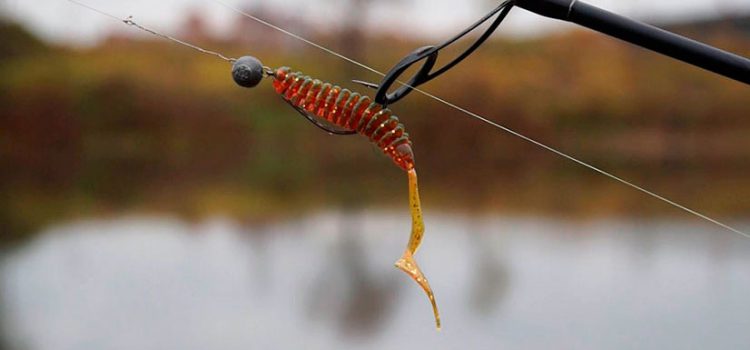
This method of fishing is a special spinning equipment, with the help of which predatory fish are caught in various water horizons, including those closer to the bottom.
As a rule, trophy specimens prefer to be at a depth and keep at a considerable distance from the coast. Therefore, it is more effective to get a trophy pike or pike perch with jig equipment.
For jig equipment, jig baits are produced. They consist of two parts: the bait itself and the jig head, a certain weight and a certain shape. The weight of the jig head is selected depending on the fishing conditions. At great depths, heavy baits are used, and lighter baits in the shallows. The shape of the bait is selected according to the nature of the bottom of the reservoir. If the bottom is muddy, then it is preferable to opt for a jig head with a flat base.
The basis of any spinning fishing is the nature of the wiring of the lure. It is obtained by moving the rod and winding the line with a reel. At first glance, everything is very simple and accessible. In fact, everything is much more complicated and success comes as a result of long training.
Spinning jig
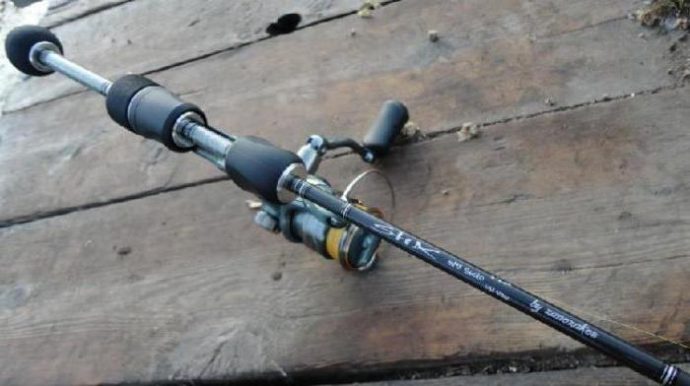
The choice of jig rod is a very important factor influencing the effectiveness of fishing. The characteristics of the rod must match the characteristics of the bait, otherwise it will not be possible to plausibly hold the bait and hook the fish in time. The spinner must feel the bait and control it. It is very important to decide on the conditions of fishing: either from the shore, or from a boat. Only after determining the main factors that you will encounter while fishing, you should start choosing a spinning rod.
If fishing will be carried out from a boat, then a long spinning rod is absolutely not needed. On the contrary, with a shorter one, it is much more convenient to catch a predator from a boat. Therefore, a spinning rod with a length of 1,9 to 2,4 meters is suitable for such conditions.
For fishing from the shore, the following philosophy is suitable: the longer the spinning, the better, since long-distance casts are indispensable. But again, the larger the spinning, the heavier it is, and this is an additional burden on the hands. Plus, there may be vegetation on the shore of the reservoir, which complicates the use of long rods. In this regard, you can focus on the following dimensions: 2,7-3,0 meters. As practice shows, such a blank is absolutely sufficient for fishing from the shore.
All rods are divided into certain categories, including the nature of the action of the rod. For jig fishing, fast or super fast action can be the most effective. This is necessary for fast and reliable hooking. In addition, fast action rods respond faster to bites. This is especially important when fishing for walleye. It has a very powerful jaw that needs to be broken through with hooking, besides, pike perch takes the bait very carefully.
Installation of jig baits (part 1)
As a general rule, this should be a reliable rod with a suitable test. The test indicates what weight of bait is best to use so that the wiring process is controlled. There are three main groups of rods, separated by test characteristics. The first group is ultralight rods, with test up to 10 grams. As a rule, it is convenient to catch perch and other small fish with such rods. The second group, with a test from 10 to 30 grams, is intended for catching a larger predator, weighing up to 10 kg inclusive. Such spinning rods are the most in demand, as they are more suitable for our fishing conditions.
The last group is rods with a test weight of more than 30 grams, which are used for fishing at great depths and at long distances, where weighty jig heads are used. A similar subspecies is relevant if you have to fish on a river with a fast current.
The material of manufacture also plays an important role. If the rod is made of modern materials, then it is not only strong, but also light. The only drawback of such forms is their high cost, which is inaccessible to a wide range of spinners.
jig coil
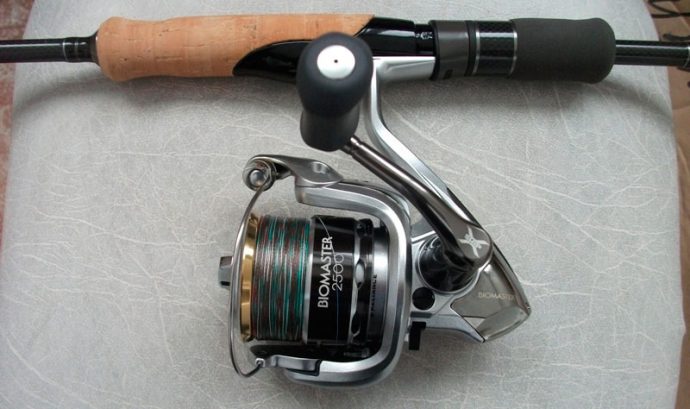
Jig fishing does not require any special equipment such as a reel. Basically, an ordinary inertialess coil of the appropriate size is used. Nowadays, more and more often they resort to installing a multiplier coil, although this is not necessary. The multiplier (marine) reel is designed for catching large specimens of fish. She will go, for example, to catch catfish. In all other cases, especially since it is more difficult to operate, it is quite possible to get by with an easier-to-use, inertial-free coil.
As a rule, experienced spinningists choose high-quality spinning reels with a special spool coating. If a braided cord is used, then a conventional plastic spool will wear out quickly. The fact is that the braid has abrasive properties. As for conventional monofilament fishing line, such requirements for the design of the reel are not put forward.
Jig line
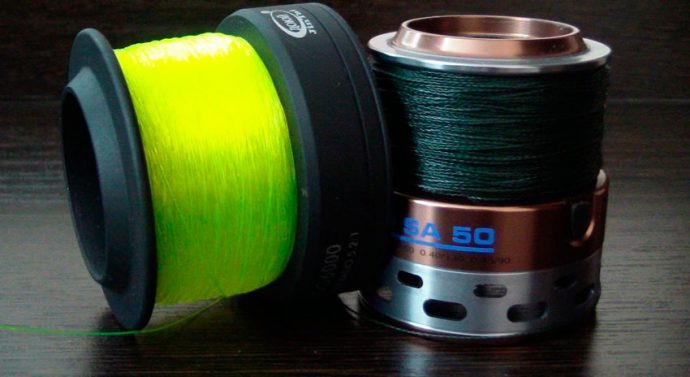
Most anglers, especially in small rivers and lakes, use monofilament line, although braided line is also possible. Unfortunately, braided line is more expensive than monoline, but monoline has a number of disadvantages, such as memory, increased specific stretch and lower strength compared to braided line. Although there are fishing conditions when there is no alternative to monofilament fishing line. Some of its disadvantages can be easily turned into its advantages.
Therefore, the choice of fishing line is dictated by the conditions of fishing. At long distances, it is preferable to use braided line, since it requires a quick transfer of bites to the tip of the rod, and at short distances, monofilament is enough, since in such conditions its extensibility does not affect performance so much. In addition, its extensibility helps to dampen the jerks of large fish.
How to properly equip JIG BAIT. 6 ways to snap.
jig atir
There are two main types of jig baits, depending on what material they are made of.
- Foam rubber lures. These are classic jig baits that are sold in retail outlets. Such baits are easy to make yourself, which is what many anglers do. The result is inexpensive home-made lures designed for various fishing conditions.
- Silikon lasisiy. Nowadays, such baits are very popular among jig fishing enthusiasts. In retail outlets, you can find a huge variety of silicone baits that differ in shape and color. Thanks to the special properties of silicone, it was possible to create baits that imitate not only various fish, but also various animals, as well as insects and other representatives of the underwater world. Various flavors are added to silicone, which increases the number of bites. This is the so-called edible rubber.
- Combined lures are created by the anglers themselves from the parts of silicone lures that have become unusable. Silicone is very easy to bond under the influence of temperature. Therefore, picking up a soldering iron, you can create your own masterpieces.
Installation of bait

There are several options for jig mounting, depending on the nature of the load:
- Hard mount jig head. This is the easiest way to mount a jig lure. In this case, the jig head is connected to the bait in such a way that the weight is in front of the bait, and the tip of the hook comes out on top of the bait.
- Mòn fleksib. This mounting option allows you to get a brighter game of the bait. The bait is put on the hook, and the load, such as “cheburashka”, is connected to the hook by means of a clockwork ring. Both conventional hooks with a long shank and offset ones can be used in the equipment. Offset hooks allow you to get a non-hooking bait.
In any case, the main thing is to choose the right hook size so that it matches the size of the bait. Quite often, double or triple hooks are used instead of single hooks. This increases the effectiveness of fishing, but at the same time increases the risk of catching on underwater obstacles. How to put the bait on a regular or double hook, you can find out on the Internet by watching the corresponding video. It is better to see once than to read several times, especially since it is not so easy to describe this process, and even more difficult to put into practice.
Fishing. Mounting the bait on the jig head
Charj

Cargoes differ not only in weight, but also in shape. Despite this, most jig heads are equipped with ball-shaped weights. They are suitable for almost all conditions of spinning fishing. In addition to spherical loads, you can also find loads in the form of a “boot” or “ironing”. As a rule, such loads are characterized by the presence of a wide lower plane, which does not allow it to fall into the silt.
fil elektrik jig
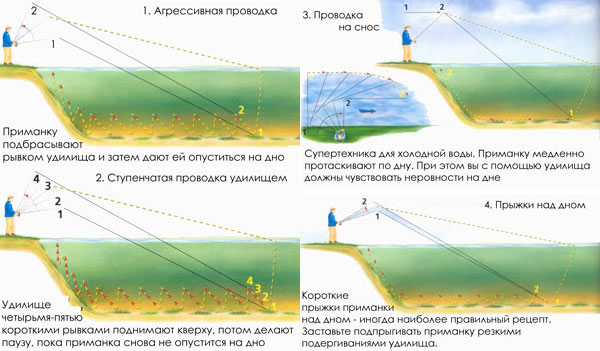
The effectiveness of jig fishing depends on a whole set of factors that in one way or another affect the performance. Equally important is the skill of the spinner. The ability to correctly set the bait and plausibly hold it so that the predator sees its prey in it and decides to attack is one of the main conditions for the effectiveness of gear.
Classic wiring is an ordinary step, which is formed either by moving the rod up or by cyclic windings of the line. If the step is formed by the movement of the rod, then after it you need to immediately choose the slack of the fishing line, otherwise you will not be able to fix the bite in time. If you make not one stroke of the rod, but several, but less short ones, you will get a large step, which will include several small steps. Such a variety attracts fish more and the result does not make you wait long.
Sometimes uniform wiring is required, which may be due to the nature of the bait used. If this is a vibrotail, then a moderate uniform wiring quite plausibly imitates the movement of a fish. Depending on the behavior of the fish, sometimes slow and sometimes fast aggressive wiring is required, which provokes a predator to attack.
Demolition wiring is used on rivers. In this case, the bait is thrown upstream somewhere at an angle of 45 degrees. The bait begins to sink to the bottom while the current blows it away. With small twitches of the rod, the bait is forced to bounce at the bottom, which attracts both pike and zander.
jig heads
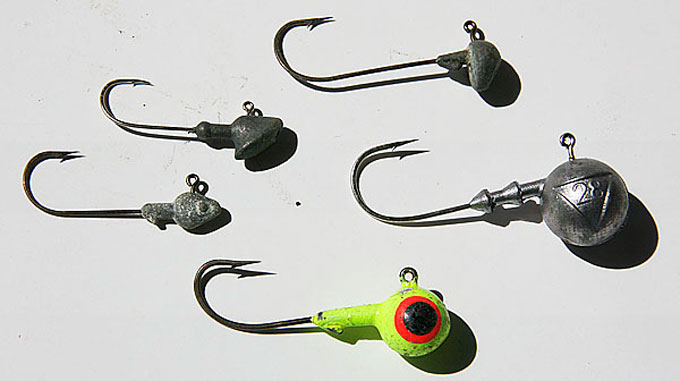
The jig head is structurally composed of a hook of the appropriate size, poured into a load of the appropriate shape and weight. As a rule, special hooks with a long shank are used for the production of jig heads. The hook is positioned so that its sting always looks up. Here on the load there is an eye for fastening, which is also directed upwards. The result is a design with a mixed center of gravity, which carries the bait down. This factor makes it easy to control the movement of the lure. The shape of the load can be any, as this does not affect its catchability.
9 ways to mount silicone lures, part 1
Kalite rig
There are several types of spinning rigs.
Texas

Equipment called Texas is characterized by the presence of a load in the form of a bullet and an offset hook, on which there is a bait in the form of a worm. The load has a hole running along its axis, as a result of which it can slide along the fishing line. At the bottom of the load there is a recess in the form of a hemisphere, in which the upper part of the bait can be hidden. When using an offset hook, its sting can be hidden in the body of the lure, which minimizes hooks.
At the same time, it is necessary to correctly select the weight of the load so that it slowly sinks to the bottom. Lures such as worms are especially effective when lowered slowly or when moving vertically.
Caroline

This is a rig similar to the previous one, with a few minor tweaks. This installation is arranged according to the principle of spaced equipment, since the load is located at a distance of 40 cm to 1 m from the bait. In this case, the weight can be dragged along the bottom, creating mud and attracting fish, and the worm-shaped bait is in a free state, which leads to its characteristic play.
Other rigs with offset hooks
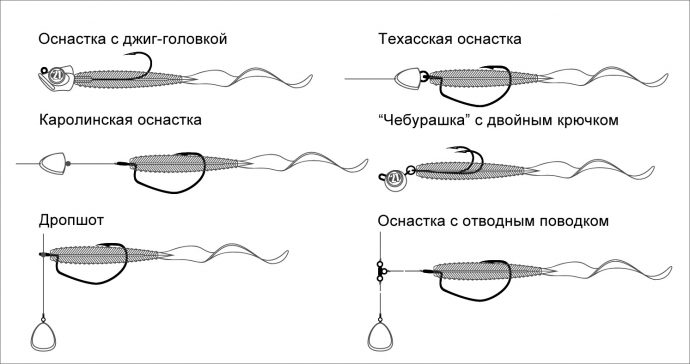
In the case of using offset hooks, it is possible to use not only worms as bait, but also other types of baits, such as slugs or shads that imitate the movement of a fish. Since the baits have a certain weight, it is not necessary to load them. Such baits catch pike well, as well as perch.
Front hook rig
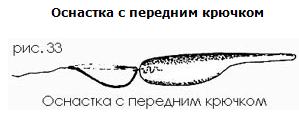
To minimize the likelihood of a hook, the hooks are equipped with plastic jumpers. For this, special spirals with rings are used, which are put on a hook in the area of uXNUMXbuXNUMXbits bend. It turns out that the bait is behind the unhooked hook. Lures such as worms or slugs can easily pass through grass due to their shape. The hook must be loaded by soldering its forearm with lead solder or lead plasticine. As a result, the design will resemble a jig head.
Equipment with a float or a wobbler
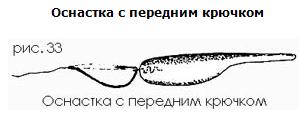
Such snap-ins are rare, because they are little known and rarely used by anyone. It is based on a light jig equipment, to which a wobbler or a horizontal float is added. This is necessary when a fixed immersion depth is required, which provides a horizontal float. Very often the fish attacks the float. In this case, the float can be replaced with a floating wobbler by removing the rear tee.
Drifting bottom rig
A similar installation is used when fishing in the current. Below the hook with the bait, at a distance of 40-60 cm, a leash with a set of weights, such as a pellet, is attached. In the case of hooks, the pellets move, freeing themselves from the hooks. As a result, the equipment always remains intact.
Petty tyrant

Such equipment consists of a load attached to the end of the main fishing line. At a distance of 20-30 cm from it there are several leashes with hooks on which baits are placed. With the help of such equipment, they catch fish in a plumb line. As a rule, it is used for fishing at sea, where there is a significant depth.
Jig equipment for pike
As you know, the pike has very sharp teeth and can easily bite through an ordinary fishing line. In this regard, it does not make sense to attach the bait directly to the fishing line. To prevent the pike from biting off the bait, a metal leash is installed between it and the fishing line. Its length depends on the size of the predator that can peck. As a rule, a 20 cm leash is sufficient. When catching large specimens, it is possible to install a 40 cm leash.
Fishing with various jig rigs.
jig fishing technique
Jig fishing technique is quite simple and effective. It allows you to catch both shallows and deep-water areas of reservoirs. After casting the bait, you need to wait for the bait to reach the bottom. Experienced spinningists determine this easily, by the slack of the fishing line. After that, you can start wiring. As practice shows, it is necessary to apply several wiring techniques in order to interest the predator. If there are no bites, then they begin to replace the bait with another, more attractive one, or switch to another type of bait in general.
When fishing from the shore, you have to make long casts, 70-100 meters, and you can’t do without a quality rod. But the most important thing is not this. The most important thing is to determine a promising place where pike or other fish can stand. You need to look for holes, as well as exits from them. Including eyebrows, after which they are actively caught.










